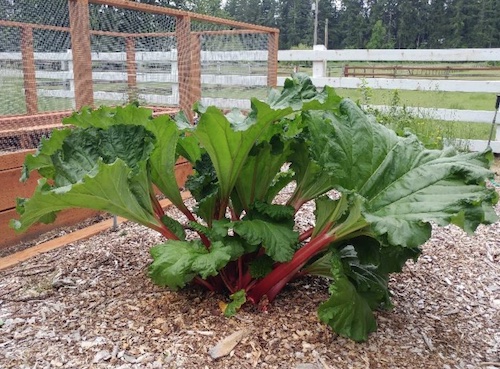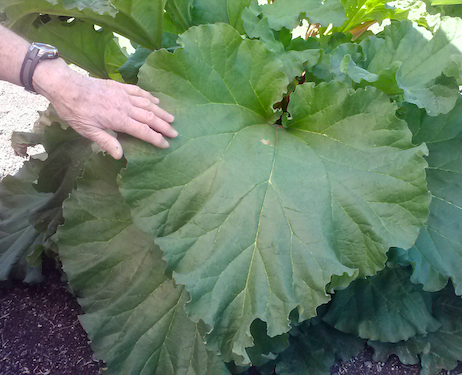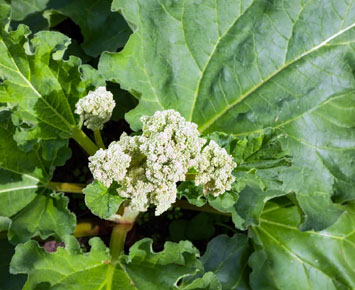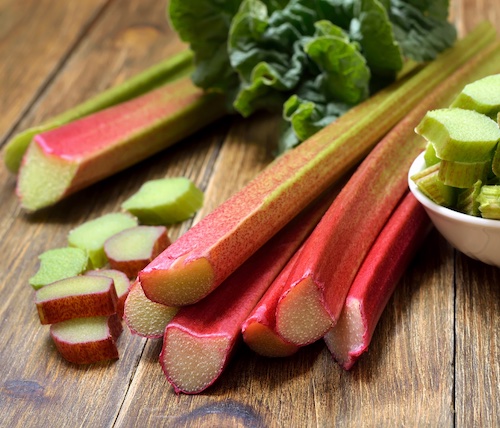The Timeless, Tasty, Sometimes Medicinal Rhubarb
by Carolyn R. Casey, Fairfax Master Gardener
 Rhubarb (Rheum rhabarbarum) is a cool season hardy perennial in the buckwheat family Polygonaceae. It provides many years of enjoyment in such favorites as strawberry rhubarb pie, offering a tasty addition to the garden. Many species of these plants are called rhubarb (and not all are botanically associated with the edible type). Edible garden rhubarb may be referred to as R. xhybridum or R. xcultorum. R. rhaponticum is a European species, which is a different false rhubarb and is occasionally misused.
Rhubarb (Rheum rhabarbarum) is a cool season hardy perennial in the buckwheat family Polygonaceae. It provides many years of enjoyment in such favorites as strawberry rhubarb pie, offering a tasty addition to the garden. Many species of these plants are called rhubarb (and not all are botanically associated with the edible type). Edible garden rhubarb may be referred to as R. xhybridum or R. xcultorum. R. rhaponticum is a European species, which is a different false rhubarb and is occasionally misused.
The Chinese used rhubarb as a therapeutic herb over 5,000 years ago. It is native to southern Siberia. The Russians named it and grew it along the Rha river (now the Volga). For centuries, it was substituted for tea as a cure for stomach aches and fevers.

Rhubarb leaf
The English began eating rhubarb leaves in the 17th century. The leaves are poisonous; they contain a toxic substance known as oxalic acid. When the leaves are eaten, they cause cramps, nausea and may even cause death.
For over 200 years, people had lost their interest in eating rhubarb because of the side effects that people experienced after eating the leaves. In the 18th century, the Europeans discovered that the edible parts of the rhubarb were the tart stalks. They began to use rhubarb in tarts, and it was given the nickname “pie plant.” Early in the 1800s, settlers brought rhubarb to America.
Rhubarb plants are easy to grow. It is one of the first crops ready for harvest in the spring. They like rich, well-drained soil that has lots of organic matter but are adaptable. Rhubarb will produce an earlier crop in lighter soils, but these plants will require frequent irrigation and fertilization.
These plants like full sun, at least 6 hours of direct sunlight every day, and are hardy in zones 4 to 7. They grow 2 to 4 feet tall (60 – 120 cm) and have large heart shaped leaves that appear in the spring when the temperature exceeds 40 degrees Fahrenheit (4º C). Flower stalks appear in the summer and grow from the crown. Small white flowers appear on each branched inflorescence. Each flower has 6 tepals and typically 9 stamens that have yellow to pinkish green anthers and three styles. After the flowers, a dry three-sided fruit with winged sides appears. The leaves may have a leaf blade that is a foot or more in width (30 cm). The red or green stalks may grow up to 18 inches long (45 cm) and have a diameter that is 1 to 2 inches (2 – 5 cm).

Rhubarb flower during bolting
Prepare the rhubarb bed in the fall in an area where it will have plenty of room to grow. The crowns should be planted 3 feet apart (1 m). Rhubarb may be grown from seed. It is usually propagated from divisions taken in the spring when it is 6 to 10 years old. This is done four to six weeks before the average last frost date. The foliage of the rhubarb plant dies back during the winter. A sharp spade or shovel can be used to cut the crown into pieces. Make sure that you have a strong bud for each piece. Leave part of the plant that has 3 to 4 buds in the original location.
The rhubarb plant is a “heavy feeder.” The plant must take in large amounts of nutrients from the soil to produce its large stalks and leaves. Make it an annual practice to supplement the soil with either a balanced commercial fertilizer or rich compost, or both. Addition of manure or compost can add micronutrients and organic matter to the soil.
Whether growth is vigorous or weak, adjust the next spring’s fertilizer application accordingly. Fertilize established rhubarb in the spring after it has started to grow and, in the summer, after it is harvested. Broadcast ½ cup of all-purpose garden fertilizer, such as 10-10-10 around each plant and then working it lightly into the soil. Do not apply the fertilizer to the plant’s crown. In most gardens, after fertilizing the plants for four to five years with a complete fertilizer, only nitrogen is needed.
Manure can be used as fertilizer by applying a 2 to 3 inch layer (5 – 7 cm) of rotted manure around the plants after growth starts in the spring. In addition to the nutrients it contains, manure also adds valuable organic matter to the soil. Manure should be supplemented with 1/4 pound of superphosphate (0-20-0) fertilizer per plant.
Do not harvest the rhubarb the first year but wait until the roots are well established and harvest the second or third year. When starting rhubarb from seed, wait until the third growing season to harvest. When planting rhubarb work manure, compost or other organic matter into the soil. Planting rhubarb in raised beds will help prevent the crown from rotting.
There are several different types of rhubarb that are classified as red, green or speckled, also known as pink. Different varieties have different levels of sourness, sweetness and fibrousness.
Recommended varieties of rhubarb are:
- ‘Canada Red’ often produces shorter, more slender stalks than other varieties but is tender and extremely sweet with good red color. It tends to produce few seed stalks.
- ‘Cherry Red’ (also known as ‘Cherry’ or ‘Early Cherry’) has long, thick stalks that are a rich red inside and out. This vigorous producer is juicy, tender and sweet.
- ‘Crimson Red’ (also called ‘Crimson,’ ‘Crimson Cherry’ or ‘Crimson Wine’) produces tall, plump, brightly colored red stalks.
- ‘MacDonald’ produces well and has tender skin on the brilliant red stalks.
- ‘Valentine’ has broad, deep red stalks that keep a good rosy color when cooked. It is much less acid than green stalked and other red varieties and produces few or no seed stalks.
- ‘Victoria’ is a speckled type that produces medium-sized stalks of excellent quality and good flavor. Although there is some variation in stalk color depending on the strain, in general the light green stalks develop pink speckling, especially at the bottom of the stalk.

Rhubarb stalks
Rhubarb is used for jams, sauces, pies and other desserts. One type of pie that is a favorite containing rhubarb is strawberry rhubarb pie. Some people strain the rhubarb and drink it as a juice. It is tart and usually needs to have sugar added to make it edible. Unwashed rhubarb stalks may be stored in the refrigerator for up to two weeks and last for up to six months when frozen.
While rhubarb can be harvested any time during the season, it is most tender and flavorful in the spring and early summer. Harvest until the end of June and then sparingly on established plants during the summer. Harvest the firm and crisp stalks that are 8 to 15 inches long (20 to 40) by twisting the stalk at the soil line and cutting off the leaf. To keep the rhubarb plant strong, do not remove any leaves from it during its first year of growth. When caring for young rhubarb plants, pick the stalks in the spring and do not pick any stalks in the summer or growth will be delayed the following spring. Remaining leaves may be removed before the first frost.
Insect pests are generally not a problem on rhubarb, but slugs and the rhubarb curculio may affect it. The curculio is a dark colored beetle that has a snout and is one-half to three-fourths of an inch long. It bores holes in the rhubarb crown and stalks. Also stalk borers can damage rhubarb. The way to control stalk borers and the rhubarb curculio is to keep grassy weeds especially curly dock away from the rhubarb.
There are two leaf spot diseases that attack rhubarb. They are Ascochyta rhei and Ramularia rhei. The best way to manage them is through selective harvesting of infected stalks combined with removing and destroying all leaves after the first hard frost in the fall.
Viruses may infect rhubarb, causing abnormal growth, loss of vigor or unusual leaf coloration. If a rhubarb plant has a virus, it is best to remove it from the garden and start over.
Phytophthora crown also known as root rot can be a serious disease for rhubarb plants. This causes the crown and roots to turn brown or black and start to disintegrate. The way to control root rot is to plant disease free plants in an area where rhubarb has not been grown for four to five years. Also, root rot can be possibly prevented by planting in well-drained soil.
There is nothing like a spring rhubarb strawberry pie. What a tasteful delight. Become acquainted with this timeless addition to your garden and once established, it provides many years of enjoyment. Bon appetit and happy rhubarb gardening!
Resources
Rhubarb, Rheum rhabarbarum, Susan Mahr, University of Wisconsin
Growing Rhubarb in Home Gardens, Jill MacKenzie, University of Minnesota Extension
Plant Some Rhubarb, Julie Weisenhorn, University of Minnesota Extension
Growing Rhubarb in the Home Garden, Erika Lyon, Curtis E Young, Marianne Riofrio, Ohio State University Extension
Rhubarb in the Home Garden, Richard Jauron, Diane Nelson, Linda Naeve, Iowa State University